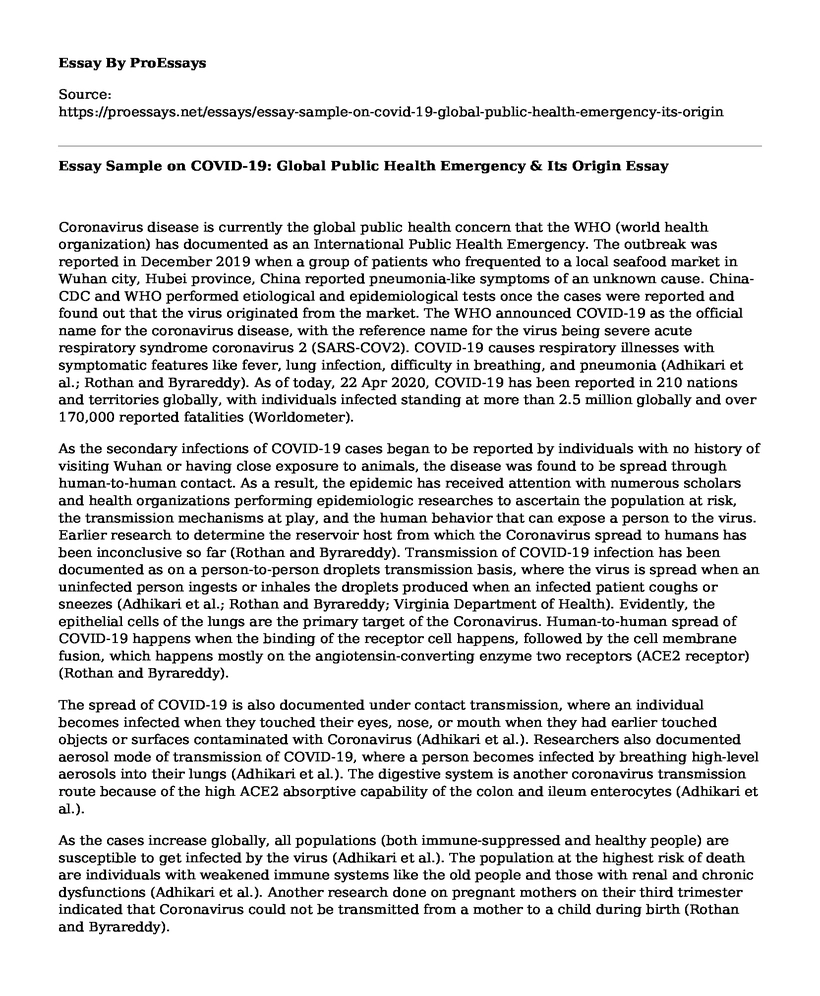Coronavirus disease is currently the global public health concern that the WHO (world health organization) has documented as an International Public Health Emergency. The outbreak was reported in December 2019 when a group of patients who frequented to a local seafood market in Wuhan city, Hubei province, China reported pneumonia-like symptoms of an unknown cause. China-CDC and WHO performed etiological and epidemiological tests once the cases were reported and found out that the virus originated from the market. The WHO announced COVID-19 as the official name for the coronavirus disease, with the reference name for the virus being severe acute respiratory syndrome coronavirus 2 (SARS-COV2). COVID-19 causes respiratory illnesses with symptomatic features like fever, lung infection, difficulty in breathing, and pneumonia (Adhikari et al.; Rothan and Byrareddy). As of today, 22 Apr 2020, COVID-19 has been reported in 210 nations and territories globally, with individuals infected standing at more than 2.5 million globally and over 170,000 reported fatalities (Worldometer).
As the secondary infections of COVID-19 cases began to be reported by individuals with no history of visiting Wuhan or having close exposure to animals, the disease was found to be spread through human-to-human contact. As a result, the epidemic has received attention with numerous scholars and health organizations performing epidemiologic researches to ascertain the population at risk, the transmission mechanisms at play, and the human behavior that can expose a person to the virus. Earlier research to determine the reservoir host from which the Coronavirus spread to humans has been inconclusive so far (Rothan and Byrareddy). Transmission of COVID-19 infection has been documented as on a person-to-person droplets transmission basis, where the virus is spread when an uninfected person ingests or inhales the droplets produced when an infected patient coughs or sneezes (Adhikari et al.; Rothan and Byrareddy; Virginia Department of Health). Evidently, the epithelial cells of the lungs are the primary target of the Coronavirus. Human-to-human spread of COVID-19 happens when the binding of the receptor cell happens, followed by the cell membrane fusion, which happens mostly on the angiotensin-converting enzyme two receptors (ACE2 receptor) (Rothan and Byrareddy).
The spread of COVID-19 is also documented under contact transmission, where an individual becomes infected when they touched their eyes, nose, or mouth when they had earlier touched objects or surfaces contaminated with Coronavirus (Adhikari et al.). Researchers also documented aerosol mode of transmission of COVID-19, where a person becomes infected by breathing high-level aerosols into their lungs (Adhikari et al.). The digestive system is another coronavirus transmission route because of the high ACE2 absorptive capability of the colon and ileum enterocytes (Adhikari et al.).
As the cases increase globally, all populations (both immune-suppressed and healthy people) are susceptible to get infected by the virus (Adhikari et al.). The population at the highest risk of death are individuals with weakened immune systems like the old people and those with renal and chronic dysfunctions (Adhikari et al.). Another research done on pregnant mothers on their third trimester indicated that Coronavirus could not be transmitted from a mother to a child during birth (Rothan and Byrareddy).
Works Cited
Adhikari, Sasmita P., et al. "Epidemiology, causes, clinical manifestation and diagnosis, prevention and control of coronavirus disease (COVID-19) during the early outbreak period: a scoping review." Infectious Diseases of Poverty, vol. 9, no. 1, 17 Mar. 2020, doi:10.1186/s40249-020-00646-x. Accessed 22 Apr. 2020.
Rothan, Hussin A., and Siddappa N. Byrareddy. "The epidemiology and pathogenesis of coronavirus disease (COVID-19) outbreak." Journal of Autoimmunity, vol. 109, 2020, ScienceDirect. doi.org/10.1016/j.jaut.2020.102433. Accessed 22 Apr. 2020.
Virginia Department of Health. "Coronaviruses." VDH, 2020, www.vdh.virginia.gov/epidemiology/epidemiology-fact-sheets/coronaviruses/. Accessed 22 Apr. 2020.
Worldometer. "Coronavirus Update (Live): 2,358,256 Cases and 161,902 Deaths from COVID-19 Virus Pandemic." Worldometer - Real Time World Statistics, 2020, www.worldometers.info/coronavirus/. Accessed 22 Apr. 2020.
Cite this page
Essay Sample on COVID-19: Global Public Health Emergency & Its Origin. (2023, May 29). Retrieved from https://proessays.net/essays/essay-sample-on-covid-19-global-public-health-emergency-its-origin
If you are the original author of this essay and no longer wish to have it published on the ProEssays website, please click below to request its removal:
- Informed Consent and Debriefing Research Paper
- Nurse Leader: Delegation and Supervising Essay Example
- Paper Example on ANA Code of Ethics: A Guide to Professional Practice in Healthcare
- Essay Example on Telehealth: Quality Healthcare Delivery via ICT Systems
- Global Employment & Underemployment: COVID-19 Impact & Solutions - Essay Sample
- Essay Example on COVID-19: Global Pandemic Threatens Nations Worldwide
- Essay Sample on Definition of Public Health







